←
SPACE WATCH
Oldest Recorded Supernova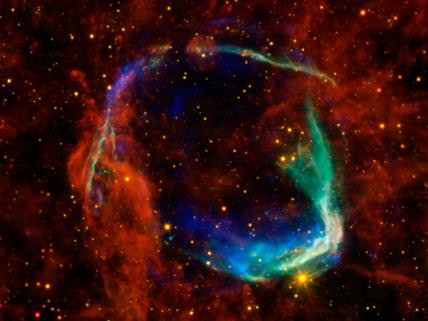 NASA – This image combines data from four space telescopes to create a multi-wavelength view of all that remains of RCW 86, the oldest documented example of a supernova. Chinese astronomers witnessed the event in 185 A.D., documenting a mysterious “guest star” that remained in the sky for eight months. X-ray images from NASA’s Chandra X-ray Observatory and the European Space Agency‘s XMM-Newton Observatory were combined to form the blue and green colors in the image. The X-rays show the interstellar gas that has been heated to millions of degrees by the passage of the shock wave from the supernova.
NASA – This image combines data from four space telescopes to create a multi-wavelength view of all that remains of RCW 86, the oldest documented example of a supernova. Chinese astronomers witnessed the event in 185 A.D., documenting a mysterious “guest star” that remained in the sky for eight months. X-ray images from NASA’s Chandra X-ray Observatory and the European Space Agency‘s XMM-Newton Observatory were combined to form the blue and green colors in the image. The X-rays show the interstellar gas that has been heated to millions of degrees by the passage of the shock wave from the supernova.
Infrared data from NASA’s Spitzer Space Telescope and WISE, Wide-Field Infrared Survey Explorer, shown in yellow and red, reveal dust radiating at a temperature of several hundred degrees below zero, warm by comparison to normal dust in our Milky Way galaxy.
By studying the X-ray and infrared data, astronomers were able to determine that the cause of the explosion was a Type Ia supernova, in which an otherwise-stable white dwarf, or dead star, was pushed beyond the brink of stability when a companion star dumped material onto it. Furthermore, scientists used the data to solve another mystery surrounding the remnant — how it got to be so large in such a short amount of time. By blowing away wind prior to exploding, the white dwarf was able to clear out a huge “cavity,” a region of very low-density surrounding the system. The explosion into this cavity was able to expand much faster than it otherwise would have.
This is the first time that this type of cavity has been seen around a white dwarf system prior to explosion. Scientists say the results may have significant implications for theories of white-dwarf binary systems and Type Ia supernovae.
RCW 86 is approximately 8,000 light-years away. At about 85 light-years in diameter, it occupies a region of the sky in the southern constellation of Circinus that is slightly larger than the full moon. This image was compiled in October 2011. Image Credit: X-ray: NASA/CXC/SAO & ESA; Infared: NASA/JPL-Caltech/B. Williams (NCSU)
Related articles
- Galactic Views (21) (theneteconomy.wordpress.com)
- Galactic Views (18) (theneteconomy.wordpress.com)
- Galactic Views (14) (theneteconomy.wordpress.com)
- Galactic Views (15) (theneteconomy.wordpress.com)
Advertisement
Source: the Net economy
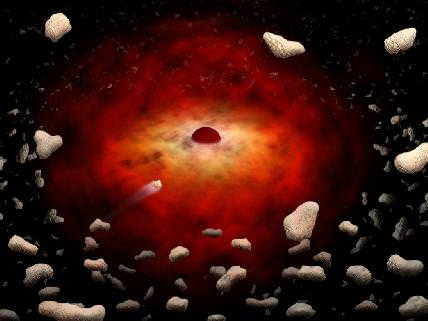 NASA – A new study provides a possible explanation of mysterious X-ray flares detected by the Chandra K-ray Observatory for several years in the region of Sagittarius A*, or Sgr A**. The study suggests a cloud around Sgr A*, a supermassive black hole at the center of our Milky Way Galaxy, which contains hundreds of trillions of asteroids and comets that have been stripped from their parent stars. The flares occur when asteroids of six miles or larger in radius are consumed by the black hole. An asteroid that undergoes a close encounter with another object, such as a star or planet, can be thrown into an orbit headed towards Sgr A*. If the asteroid passes within about 100 million miles of the black hole, roughly the distance between the Earth and the sun, it is torn into pieces by the tidal forces from the black hole. These fragments would then be vaporized by friction as they pass through the hot, thin gas flowing onto Sgr A*, similar to a meteor heating up and glowing as it falls through Earth’s atmosphere. A flare is produced and eventually the remains of the asteroid are swallowed by the black hole. Image Credit: Illustrations: NASA/CXC/M.Weiss
NASA – A new study provides a possible explanation of mysterious X-ray flares detected by the Chandra K-ray Observatory for several years in the region of Sagittarius A*, or Sgr A**. The study suggests a cloud around Sgr A*, a supermassive black hole at the center of our Milky Way Galaxy, which contains hundreds of trillions of asteroids and comets that have been stripped from their parent stars. The flares occur when asteroids of six miles or larger in radius are consumed by the black hole. An asteroid that undergoes a close encounter with another object, such as a star or planet, can be thrown into an orbit headed towards Sgr A*. If the asteroid passes within about 100 million miles of the black hole, roughly the distance between the Earth and the sun, it is torn into pieces by the tidal forces from the black hole. These fragments would then be vaporized by friction as they pass through the hot, thin gas flowing onto Sgr A*, similar to a meteor heating up and glowing as it falls through Earth’s atmosphere. A flare is produced and eventually the remains of the asteroid are swallowed by the black hole. Image Credit: Illustrations: NASA/CXC/M.Weiss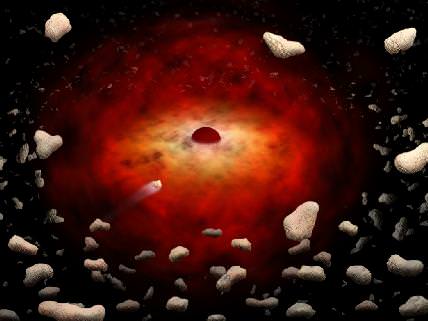 NASA – A new study provides a possible explanation of mysterious X-ray flares detected by the Chandra K-ray Observatory for several years in the region of Sagittarius A*, or Sgr A**. The study suggests a cloud around Sgr A*, a supermassive black hole at the center of our Milky Way Galaxy, which contains hundreds of trillions of asteroids and comets that have been stripped from their parent stars. The flares occur when asteroids of six miles or larger in radius are consumed by the black hole. An asteroid that undergoes a close encounter with another object, such as a star or planet, can be thrown into an orbit headed towards Sgr A*. If the asteroid passes within about 100 million miles of the black hole, roughly the distance between the Earth and the sun, it is torn into pieces by the tidal forces from the black hole. These fragments would then be vaporized by friction as they pass through the hot, thin gas flowing onto Sgr A*, similar to a meteor heating up and glowing as it falls through Earth’s atmosphere. A flare is produced and eventually the remains of the asteroid are swallowed by the black hole. Image Credit: Illustrations: NASA/CXC/M.Weiss
NASA – A new study provides a possible explanation of mysterious X-ray flares detected by the Chandra K-ray Observatory for several years in the region of Sagittarius A*, or Sgr A**. The study suggests a cloud around Sgr A*, a supermassive black hole at the center of our Milky Way Galaxy, which contains hundreds of trillions of asteroids and comets that have been stripped from their parent stars. The flares occur when asteroids of six miles or larger in radius are consumed by the black hole. An asteroid that undergoes a close encounter with another object, such as a star or planet, can be thrown into an orbit headed towards Sgr A*. If the asteroid passes within about 100 million miles of the black hole, roughly the distance between the Earth and the sun, it is torn into pieces by the tidal forces from the black hole. These fragments would then be vaporized by friction as they pass through the hot, thin gas flowing onto Sgr A*, similar to a meteor heating up and glowing as it falls through Earth’s atmosphere. A flare is produced and eventually the remains of the asteroid are swallowed by the black hole. Image Credit: Illustrations: NASA/CXC/M.Weiss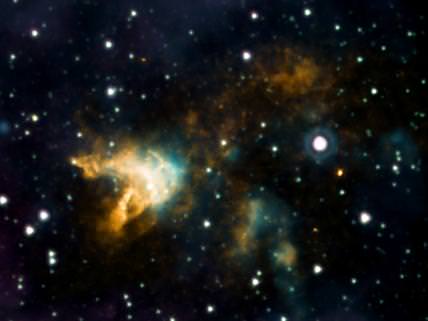 NASA – Vital clues about the devastating ends to the lives of massive stars can be found by studying the aftermath of their explosions. In its more than twelve years of science operations, NASA’s Chandra X-ray Observatory has studied many of these supernova remnants sprinkled across the galaxy.
NASA – Vital clues about the devastating ends to the lives of massive stars can be found by studying the aftermath of their explosions. In its more than twelve years of science operations, NASA’s Chandra X-ray Observatory has studied many of these supernova remnants sprinkled across the galaxy.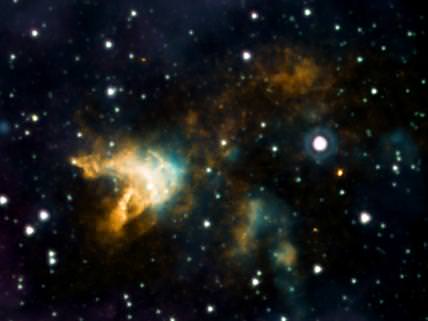 NASA – Vital clues about the devastating ends to the lives of massive stars can be found by studying the aftermath of their explosions. In its more than twelve years of science operations, NASA’s Chandra X-ray Observatory has studied many of these supernova remnants sprinkled across the galaxy.
NASA – Vital clues about the devastating ends to the lives of massive stars can be found by studying the aftermath of their explosions. In its more than twelve years of science operations, NASA’s Chandra X-ray Observatory has studied many of these supernova remnants sprinkled across the galaxy.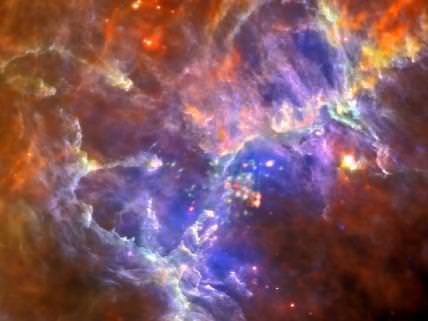 NASA – Combining almost opposite ends of the electromagnetic spectrum, this composite of the Herschel in far-infrared and XMM-Newton’s X-ray images shows how the hot young stars detected by the X-ray observations are sculpting and interacting with the surrounding ultra-cool gas and dust, which, at only a few degrees above absolute zero, is the critical material for star formation itself. Both wavelengths would be blocked by Earth’s atmosphere, so are critical to our understanding of the lifecycle of stars. Image Credit: ESA/Herschel/PACS/SPIRE/Hill, Motte, HOBYS Key Programme Consortium
NASA – Combining almost opposite ends of the electromagnetic spectrum, this composite of the Herschel in far-infrared and XMM-Newton’s X-ray images shows how the hot young stars detected by the X-ray observations are sculpting and interacting with the surrounding ultra-cool gas and dust, which, at only a few degrees above absolute zero, is the critical material for star formation itself. Both wavelengths would be blocked by Earth’s atmosphere, so are critical to our understanding of the lifecycle of stars. Image Credit: ESA/Herschel/PACS/SPIRE/Hill, Motte, HOBYS Key Programme Consortium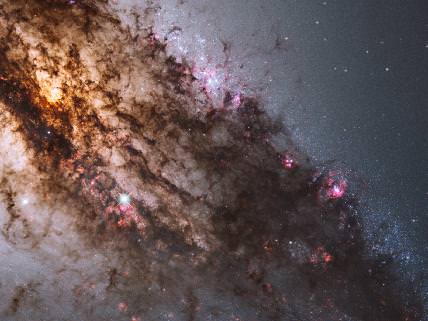 NASA – Resembling looming rain clouds on a stormy day, dark lanes of dust crisscross the giant elliptical galaxy Centaurus A.
NASA – Resembling looming rain clouds on a stormy day, dark lanes of dust crisscross the giant elliptical galaxy Centaurus A.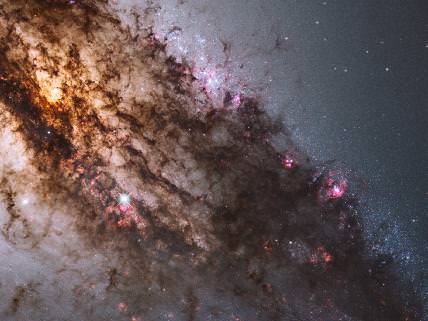 NASA – Resembling looming rain clouds on a stormy day, dark lanes of dust crisscross the giant elliptical galaxy Centaurus A.
NASA – Resembling looming rain clouds on a stormy day, dark lanes of dust crisscross the giant elliptical galaxy Centaurus A. NASA – With the holiday season in full swing, a new image from an assembly of telescopes reveals a pulsar that appears like a spinning cosmic ornament. Combined data from NASA’s Chandra X-ray Observatory and ESA’s XMM-Newton were used in the discovery of a young pulsar in the remains of a supernova located in the Small Magellanic Cloud, or SMC. This is the first time a pulsar, which is a spinning, ultra-dense star, has been found in a supernova remnant in the SMC, a small satellite galaxy to the Milky Way.
NASA – With the holiday season in full swing, a new image from an assembly of telescopes reveals a pulsar that appears like a spinning cosmic ornament. Combined data from NASA’s Chandra X-ray Observatory and ESA’s XMM-Newton were used in the discovery of a young pulsar in the remains of a supernova located in the Small Magellanic Cloud, or SMC. This is the first time a pulsar, which is a spinning, ultra-dense star, has been found in a supernova remnant in the SMC, a small satellite galaxy to the Milky Way.